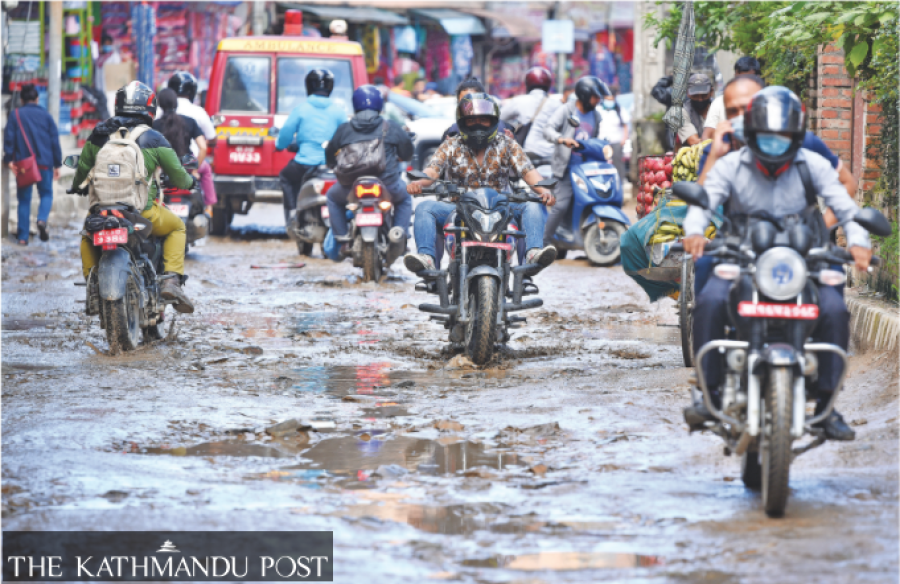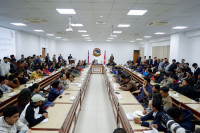National
Rain damage to roads, bridges estimated at Rs3 billion
With this year witnessing an extended monsoon, the scale of damage has been bigger, according to the Department of Roads.
Prithvi Man Shrestha
Landslides and floods during this year’s long monsoon have caused massive damage to the roads and bridges in various parts of the country. According to the officials at the Department of Roads, the estimated damage this year is worth nearly Rs3 billion, which is significantly high compared to the past several years.
The landslides and floods damaged roads in 227 various locations, according to the department, with over two dozen bridges damaged in various locations.
“Our initial estimate is that landslides and floods caused damage worth Rs2.8 billion to roads and bridges,” said Shiva Prasad Nepal, spokesperson at the department. “The value of actual damage can be confirmed only after conducting a detailed survey.”
In mid-monsoon last year, the department had estimated the damage caused to the road infrastructure at over Rs2 billion.
“As many as 27 bridges have suffered damage and this is one of the reasons for the value of damage to bloat significantly,” he said.
“Two nearly five decades old bridges were damaged in the Butwal-Narayangadh section and three bridges were damaged in the Melamchi area due to massive flooding on the Melamchi river.”
The floods on the Melamchi river in June also caused damage to the headworks and temporary structure of the Melamchi Drinking Water Project affecting the water supply in the Kathmandu Valley.
According to the department, the road connecting Besishahar of Lamjung and Chame of Manang suffered the biggest losses. Continuous heavy rainfall in the middle of June had caused flooding on many small rivers and rivulets in Manang with floodwaters entering villages and causing damage. The incessant rainfall also damaged the Besisahar-Manang road badly.
“Makeshift repairs are almost complete and the transportation services are likely to resume within a few days on this road section too,” said Nepal. Likewise, Araniko Highway, the road in the Melamchi area, Butwal-Narayangadh Road, and Pokhara-Baglung roads also suffered substantial damage, according to the department.
Department officials say that the country’s major highways have been vulnerable due to haphazard construction of link roads. They bring water and debris to the highways and cause landslides, they say.
Federal, provincial, and local governments allocate a substantial amount of budget to road construction. The central government is itself handling around 1,440 local roads and an equal number of bridges are also under construction. Even though the federal government announced that it had suspended implementing 1,400 small road projects, for the time being, it is preparing to hand them over to provincial and local governments.
Likewise, provincial and local governments also construct roads from their own resources. “The focus has wrongly been on building more roads than quality roads,” said Nepal. Officials at the department say they have been writing to the local governments to stop the reckless construction of rural roads.
With this year witnessing an extended monsoon, the scale of damage has been bigger. Repair and maintenance works have also been affected by the continuous rainfalls,” said Arjun Jung Thapa, director general at the department.
According to Deputy Director General of the Department of Hydrology and Meteorology Archana Shrestha, the monsoon is expected to linger beyond mid-October this year. “Besides the extended monsoon, haphazard construction of infrastructure without risk-mitigating measures have also caused landslides and flooding,” she said.
Officials at the department say that they have also started utilising modern technology to prevent landslides along the highways.
For example, the department used a geo-tech solution for preventing landslides along the Mugling-Narayangadh Road in 2019 which officials said has resulted in fewer landslides, according to officials at the department. Geo-tech solution ( engineering) is a branch of civil engineering which is concerned with the behaviour of earth materials.
Nepal remains vulnerable to many natural and human-induced hazards, says the Disaster Risk Reduction in Nepal: Status Report 2019. Floods kill nearly 150 people in Nepal every year.




 16.12°C Kathmandu
16.12°C Kathmandu















